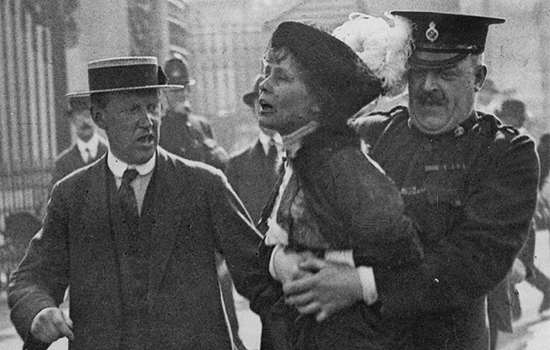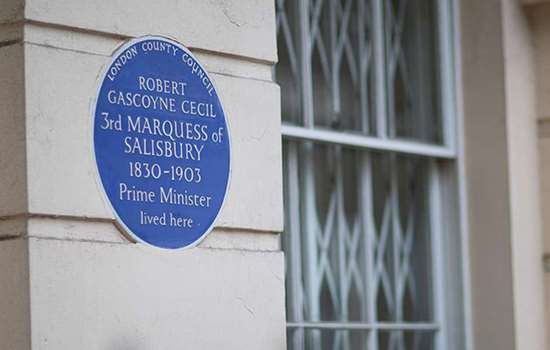MARKOVA, Alicia (1910–2004)
Plaque erected in 2025 by English Heritage at 7 Cascade Avenue, Muswell Hill, N10 3PT, London Borough of Haringey
All images © English Heritage
Profession
Prima Ballerina
Category
Music and Dance
Inscription
Dame ALICIA MARKOVA (LILIAN ALICIA MARKS) 1910−2004 Prima Ballerina lived here as a child
Material
Ceramic
Alicia Markova was one of the greatest ballet dancers of the 20th century and the first British-born prima ballerina. She helped ensure the success of the companies that became the Royal Ballet and the English National Ballet, two cornerstones of British ballet today. Markova is commemorated by a blue plaque at her childhood home, 7 Cascade Avenue, Muswell Hill where she lived when she developed her life-long love of dancing.
Lily Marks – as she was known as a child – was born in Finsbury Park in 1910, the eldest of four girls. Her family moved a lot in her early life but from 1914 they settled at 7 Cascade Avenue in Muswell Hill, a newly built home in the Rookfield Estate, a pleasant garden suburb. Her father took her to watch Arsenal at Highbury stadium and, from around the age of seven, Marks attended weekly dance classes in Muswell Hill on the advice of a doctor, who thought that the exercise might correct her ‘flat feet, knock knees, and weak legs.’
Marks soon became stronger, and her teacher spotted her rare talent. Aged eight, she won a talent show at her first public performance. At home she made elaborate costumes and performed with her sisters on a stage her father built in the garden. When she was nine, Marks watched Anna Pavlova dance and begged her father to be allowed to meet the famous ballerina at her home in Hampstead. Upon meeting, Pavlova watched Marks dance and advised her to take care of her health.
The ‘Child Pavlova’
In 1920 Marks made her first professional appearance in a production of Dick Whittington. She was billed as ‘Little Alicia – The Child Pavlova’. The great Russian ballet teacher, Princess Seraphine Astafieva was angered by the presumptive comparison but when she saw Marks dance, she welcomed her as a pupil at her studio on the King’s Road, Chelsea. Marks proved a remarkably fast learner.
Marks continued training and performed at the London Palladium in 1923. In her first interview she admitted practising for five hours a day on top of lessons. Though she encountered anti-Semitism, especially at the start of her career, she refused to have plastic surgery on her nose to conform to others’ ideas of beauty.
While Marks worked to achieve her dream of becoming a ‘great dancer’, her family struggled financially and they had to leave their Muswell Hill home. In 1924, her father took his own life. The family were left devastated and dependent on Marks and her promising talent.
Alicia Markova and the Ballets Russes
In December 1924, Diaghilev invited Marks to join the Ballets Russes, based in Monte Carlo. It was unprecedented for a 14-year-old child to join a ballet company and, though too young to legally work abroad, Marks left London chaperoned by her eldest sister and Ninette de Valois. Diaghilev gave her the stage name of ‘Alicia Markova’ and she made her début as Little Red Riding Hood in spring 1925.
Markova next appeared in Le Chant de Rossignol wearing a silk costume designed by Henri Matisse and was coached in the score by Igor Stravinsky. She joined the corps de ballet (a permanent part of the company that dances in synchrony) in 1927 and trained with virtuoso performer and teacher Enrico Cecchetti, whose demanding regime taught her the lightness for which she became renowned. Markova toured Europe and was nurtured by Diaghilev.
Rise to Prima Ballerina
Markova’s career suffered a major setback when, in 1929, Diaghilev suddenly died, and the company closed. She endured months without work and mourned the loss of her ‘artistic father.’
The following year, choreographer Frederick Ashton invited Markova to partner him in a new production. Other roles followed and in 1932 she danced in front of John Logie Baird’s newly invented television camera.
Markova was invited to become prima ballerina in the Vic-Wells Ballet (which later became the Royal Ballet) in 1933. She supplemented her salary by dancing in the breaks between films at the Regal Cinema in Marble Arch.
In 1934 she made her début in the title role of Giselle, paired with Anton Dolin who she had trained with at Astafieva’s ballet school. She followed this with performances in Swan Lake and The Nutcracker, which established her fame. Markova and Dolin toured the country and introduced new audiences to both classic ballet and newer works.
Touring the world
Markova joined a new company, the Ballet Russe de Monte Carlo, in 1938. Her debut in New York was greeted with ecstatic reviews. After fracturing her foot the following night, she switched to a less demanding part only nine days later and set off on tour.
Although Markova was paid $1000 a week, she worked at a phenomenal rate, touring North and South America, the Caribbean and the Philippines.
In 1948 Markova finally returned to London to dance at the Royal Opera House in Giselle, Swan Lake and The Sleeping Beauty. Determined to bring ballet to the widest audience, she also danced in front of thousands at the Empress Hall in Earls Court and the Harringay Arena in Green Lanes, where hot dogs were served in the interval.
English National Ballet
In 1950 Markova, Dolin and the impresario Julian Braunsweg formed a new company named the Festival Ballet after the imminent Festival of Britain. Markova left in 1952, but had founded what later became the English National Ballet.
Markova was awarded a CBE in 1958 and DBE in 1963. That year, she announced her retirement from dancing, aged 52. She became a director and professor and was governor of the Royal School of Ballet from 1973 and President of the English National Ballet from 1986 until 2004. She died in 2004, aged 94. Markova was devoted to her profession and once astutely observed, ‘my life has been one long series of pirouettes from city to city.’
Further reading
-
Tina Sutton, Becoming Markova, 2012
-
Nadine Meisner, ‘Markova, Dame Alicia [real name Lilian Alicia Marks] (1910–2004)’, Oxford Dictionary of National Biography (2011) (access with a UK public library card)


